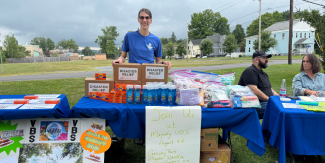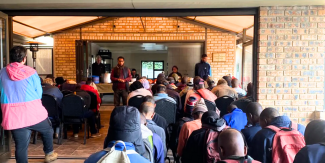APRIL 13, 2022 · NELL BECKER SWEEDEN
This article originally appeared in Holiness Today in 2009. Any facts and figures were accurate at the time of publication. Reprinted with permission. Read the original article here.

Tom Nees, former Nazarene Compassionate Ministries and USA/Canada Mission/Evangelism director, was once asked, "How did you know that God was calling you to start Community of Hope?" Nees simply responded: "I couldn't not do it."
In the 1970s, Nees began Community of Hope, an urban church in Washington, D.C., as a gathering place for people in need. From a small group of people listening to the concerns of their neighbors and working to create decent affordable housing in the neighborhood, the ministry soon expanded. Eventually it would include health and social services, legal aid, youth and children's activities, emergency assistance, and counseling.
Beginning with a compassionate conscience, Community of Hope became a compassionate ministry center. In reflecting on the compelling urge Nees felt to begin an inner city ministry, one discovers that a church congregation seeking to live compassionately in its community discerns this same motivation—we can't not do it.
We can't not do it because we are compelled by God's love for us to show this same love to others.
This simple beginning can soon become an eruption of compassion. Nazarene Compassionate Ministries (NCM) seeks to come alongside such congregations and help provide them with guidance, partnership, resources, and training to live compassionately in their neighborhoods. A congregation can begin to address community needs by assessing its local community and church family.
Beginning steps:
- Pray. Begin a prayer team and do prayer walks in your community asking God to lead you in how to respond to the concerns of your neighbors.
- Map the community. Who resides nearby? What needs are in the community? What might be causing some of those needs?
- Survey what services already exist in your surrounding area. Look online or in the phone book for local food banks, rescue homes, social services, and so on.
- Assess possible local partners and resources. Visit and volunteer. Get to know other service organizations nearby.
- Look for resources and skills within your congregation. For example, who is willing and able to volunteer? Does your church put on a great potluck? Do any people in your church have basic construction skills? Do you have a gym or classrooms that aren't being used throughout the week?
All of these are assets, resources, and skills that can be used in living out compassion in your community. The goal is to start simply. Your compassionate outreach could be as basic as setting up a team of volunteers and a schedule to visit a local nursing home, or to serve food at a soup kitchen once a week. The opportunities are endless.
Compelled by God's love, a congregation cannot help but seek every avenue, form, and partnership to reach out to others and so transform them by the love of Christ. A compassionate lifestyle is a lifestyle of gospel reflection and transformation. As God's children, we can't not do it.
---
Nell Becker Sweeden is the director of Nazarene Compassionate Ministries.






Add new comment